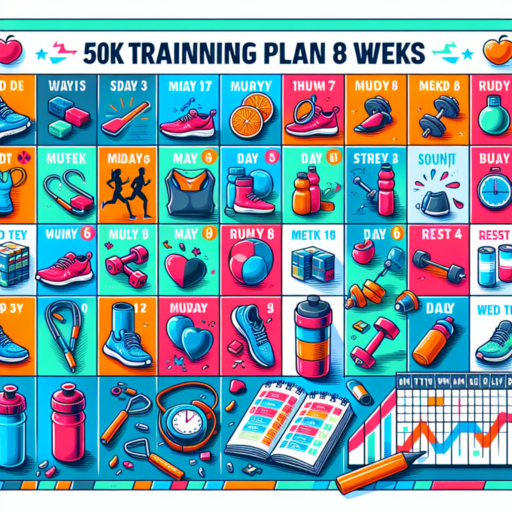Introduction to Your 25k Trail Race Training Plan
Welcome to the starting line of your 25k trail race journey! Trail running represents not just a test of endurance, but also an adventure through the natural world, offering challenges and landscapes that traditional road races can’t match. Training for a trail race, especially one as demanding as a 25k, requires a unique approach to both running and strength training. Through this guide, we aim to provide you with a solid foundation to not only reach the finish line but to enjoy the journey along the trails as well.
Before lacing up your shoes and hitting the trail, it’s essential to understand the distinct demands a 25k trail race places on your body. Unlike road races, trail races involve varied terrain, elevation changes, and potential obstacles. Thus, your training plan needs to be adaptable and multifaceted, focusing not only on distance but also on building the strength and agility needed to navigate technical trails safely and efficiently. This introduction will outline what you can expect from your 25k trail race training plan, setting the stage for a successful and enriching race experience.
Your journey begins with a commitment to both consistent training and mindful recovery. A well-rounded 25k trail race training plan will guide you through increasing your mileage gradually, incorporating essential strength training exercises, and including necessary rest days to allow for physical and mental rejuvenation. To ensure a comprehensive preparation, we will explore various elements of training including endurance building, strength workouts, and recovery techniques. Let this introduction be your first step towards an unforgettable trail running adventure.
Essential Gear for Your 25k Trail Race Prep
Preparing for a 25k trail race involves meticulous planning and the selection of appropriate gear. The terrain of a trail race presents unique challenges, making the right equipment crucial for both your performance and safety. From footwear to hydration, each piece plays an integral role in helping you cross the finish line.
Footwear: The Foundation of Your Trail Race Gear
When it comes to trail running, the importance of choosing the right footwear cannot be overstated. Look for shoes that offer ample grip and traction, designed to handle various terrains, from muddy paths to rocky inclines. A shoe with a durable, water-resistant upper will keep your feet dry, while adequate cushioning will provide the necessary support for your joints over long distances.
Hydration Packs: Staying Hydrated on the Move
Hydration is key in endurance races like a 25k trail. Unlike traditional races where water stations are common, trail races often feature less frequent hydration points. A lightweight hydration pack is essential, allowing you to carry water and electrolyte drinks hands-free. Opt for a pack with easy-to-access pockets for gels and snacks to maintain your energy levels throughout the race.
Navigational Tools and Safety Gear
Last but certainly not least, ensuring your safety during a trail race is paramount. A compact, waterproof GPS device can help you stay on track, while a basic first aid kit can address minor injuries until professional medical help is available. Additionally, consider carrying a whistle and a lightweight headlamp or flashlight in case you find yourself on the trail after dusk.
Week-by-Week Breakdown: The Ultimate 25k Trail Race Training Schedule
Embarking on a 25k trail race presents an exhilarating challenge that requires diligent preparation and an effective training schedule. Whether you’re a seasoned runner aiming to improve your time or a novice eager to embark on your first trail race, this week-by-week breakdown is designed to guide you toward achieving your goals. From establishing a solid foundation to incorporating essential strength training and rest days, each phase of this schedule is crafted to gradually enhance your endurance, speed, and confidence on the trail.
Building a Strong Foundation: Weeks 1-4
The initial four weeks are crucial for establishing a solid running base. Focus on consistent, easy-paced runs to acclimate your body to regular running. Include three to four runs per week, starting with shorter distances and progressively adding mileage. It’s also beneficial to incorporate one day of cross-training to improve overall fitness while minimizing the risk of injury. At this stage, the emphasis is on building endurance, so patience and persistence are key.
Increasing Intensity and Distance: Weeks 5-12
As you move into the next phase, the training intensifies with the introduction of hill workouts and longer distance runs. These elements are pivotal for strengthening your legs and boosting your cardiovascular system, which are essential for trail running. During these weeks, ensure one long run each week, gradually extending the distance to build stamina while still allowing for adequate recovery. Incorporating varied terrain into your long runs can simulate race conditions and improve your adaptability on the trails.
Sharpening Speed and Tapering: Weeks 13-20
In the final stretch leading up to the race, focus shifts towards sharpening your speed and reducing the total mileage to ensure your body is well-rested and prepared for race day. Introduce one session of speed work per week, such as interval training or tempo runs, to enhance your anaerobic capacity and racing speed. During the tapering period, gradually decrease your mileage, giving your muscles ample time to recover. This period is also an opportunity to fine-tune your race strategy and mental preparation, ensuring you’re both physically and mentally ready for the challenge ahead.
Strength and Conditioning Exercises for Trail Runners
Trail running demands not just endurance, but also a significant amount of strength and stability from your body. Incorporating strength and conditioning exercises into your training regimen is essential to improve performance and reduce the risk of injury. These exercises focus on building the muscular strength and endurance needed to tackle unpredictable terrains, steep inclines, and longer distances encountered during trail running.
One of the key areas to concentrate on is the lower body, particularly the legs and core. Exercises such as squats, lunges, and deadlifts are foundational movements that enhance leg strength. Additionally, incorporating plyometric exercises like box jumps and hill repeats can improve power, which is crucial for pushing off rocky terrains and uphill segments efficiently. Core exercises, including planks, Russian twists, and bicycle crunches, provide the stability needed to navigate the technical trails and maintain balance over uneven surfaces.
Beyond lower body strength, trail runners should not neglect upper body conditioning. Exercises like pull-ups, push-ups, and dumbbell rows build upper body strength, improving posture and aiding in balance during long runs. A strong upper body also contributes to better arm drive, which can be particularly beneficial during steep incline runs. Therefore, a comprehensive strength and conditioning program for trail runners should include a balanced mix of lower and upper body workouts to ensure overall body strength and endurance.
Nutritional Strategies to Fuel Your 25k Trail Race Training
Training for a 25k trail race is not just about the miles you log but also about optimizing your nutrition to support your body’s needs. A strategic approach to your diet can enhance your performance, recovery, and overall training experience. It’s crucial to focus on a balanced intake of macronutrients—carbohydrates, proteins, and fats—while not overlooking the importance of micronutrients and hydration.
Carbohydrate Loading and Timing
Carbohydrates are your body’s primary fuel source during high-intensity endurance training. Incorporating a variety of complex carbohydrates such as whole grains, vegetables, and fruits into your diet ensures a steady energy release. Timing your carbohydrate intake is also key. Consuming a carbohydrate-rich meal or snack a couple of hours before long runs can significantly improve your endurance and performance.
Protein for Muscle Recovery
Protein plays a critical role in muscle repair and recovery after strenuous workouts. Including a good protein source in your diet after training sessions helps to accelerate muscle recovery. Lean meats, fish, eggs, dairy products, legumes, and plant-based proteins are excellent choices. It’s beneficial to spread protein intake evenly throughout the day and incorporate it into each meal and snack to facilitate ongoing muscle repair and growth.
Hydration and Electrolyte Balance
Staying hydrated is paramount, especially during long training runs and on race day. Dehydration can significantly impact your performance and recovery. It’s essential to drink plenty of fluids before, during, and after your runs. Additionally, replenishing electrolytes lost through sweat, with natural sources like bananas for potassium or a sports drink for sodium and other minerals, can help maintain your body’s balance and ensure optimal functioning during your 25k trail race training.
No se han encontrado productos.
Overcoming Common Challenges in Trail Race Training
Training for a trail race presents a unique set of challenges, each requiring a tailored approach to overcome. From unpredictable weather conditions to varied terrain, the preparation phase is both physically and mentally demanding. Understanding these hurdles is the first step towards devising strategies that can help athletes navigate them successfully.
Adapting to Diverse Terrain
One of the foremost difficulties in trail race training is the unpredictable nature of the terrain. Whether it’s steep inclines, slippery mud, or uneven paths, each type of ground tests different muscle groups and aspects of one’s balance and agility. Incorporating a variety of running surfaces in your training regime is essential. Exercises that enhance core strength and stability can also be particularly beneficial, as they improve your ability to maintain balance on uneven surfaces.
Weathering the Elements
Another significant challenge faced by trail racers is the capriciousness of the weather. Sudden rain can transform a familiar trail into a treacherous path, while unexpected heatwaves can lead to dehydration if not properly prepared for. To overcome these obstacles, it’s important to monitor weather forecasts closely in the days leading up to your training sessions and races, and to plan accordingly. Adapting your gear and hydration strategy based on expected conditions can make a substantial difference in your performance and safety.
Tips for Tackling Technical Terrain
Navigating through technical terrain requires not just physical skills, but also a well-thought-out strategy. Whether you’re traversing rocky paths, steep inclines, or uneven ground, the key to success lies in preparation and the right approach. Here are essential tips to help you conquer challenging landscapes effectively.
Understand Your Terrain
Before setting out, it’s crucial to have a deep understanding of the technical terrain you’ll be encountering. Research the area, study maps, and read trip reports from others who have navigated the terrain. Knowledge about the type of rock, steepness of inclines, and potential weather conditions can significantly impact your strategy.
Equip Properly
Having the right gear can make a significant difference when tackling technical terrain. Opt for footwear that provides both traction and stability. Lightweight but durable clothing can help you move more freely. Additionally, consider tools like trekking poles for balance and protective gear such as helmets and gloves for safety. Choosing equipment tailored to the specific challenges you’ll face is not just smart; it’s essential for safety and success.
Master Your Techniques
Fine-tuning your techniques can greatly enhance your ability to navigate through challenging landscapes. Practice skills such as scrambling, precise foot placement, and using your hands for balance. Courses or guided instructions can offer valuable insights and techniques tailored to technical terrains. Remember, efficiency and safety go hand-in-hand when traversing difficult paths.
The Mental Game: Preparing Your Mind for Race Day
Preparing your mind for race day is as critical as physical training, yet often underrated. Mental toughness can significantly influence performance, making mental preparation a pivotal aspect of any athlete’s regimen. This often involves a variety of strategies, including visualization, goal setting, and developing a positive mindset, which can help you overcome the inevitable challenges that come with competitive racing.
Visualization is a powerful tool for mental preparation. It involves picturing yourself successfully navigating the course, overcoming obstacles, and crossing the finish line. This technique not only helps in enhancing focus but also boosts confidence by mentally simulating the race experience. Athletes often visualize various scenarios, including possible setbacks, to prepare themselves for any race day eventuality, ensuring they remain composed and adaptable.
Setting realistic yet challenging goals is another essential step in mental preparation for race day. Goals give direction and purpose to the training process, providing clear markers of progress and success. It’s important to set goals that are achievable but also push you to your limits, as this fosters a sense of accomplishment and motivation. Inclusion of short-term objectives leading up to the race can also help in maintaining focus and improving performance incrementally.
Recovery Techniques to Keep You Training Strong
In the world of athletics and fitness, recovery is as critical as the training itself. Effective recovery techniques can significantly enhance your performance, allowing you to train continuously while minimizing the risk of injury. Here, we delve into a few proven strategies that can help keep your body in top shape and your training on track.
Implement Active Recovery
Active recovery plays a pivotal role in aiding your muscles to recover faster while gently improving range of motion. Activities like light jogging, swimming, or cycling at a low intensity, especially after a strenuous workout, keep the blood flowing and help in flushing out lactic acid from the muscles. Incorporating yoga and stretching exercises on your rest days also promotes muscle elasticity and prevents stiffness, setting a firm ground for your next high-intensity training.
Nutrition and Hydration
A critical but often overlooked aspect of recovery is nutrition and hydration. Consuming proteins and carbohydrates immediately after your workout can significantly reduce muscle soreness and speed up the recovery process. Hydration, similarly, is essential as water supports metabolic function and nutrient transfer. Considering electrolyte-replenishing beverages post-exercise is also beneficial, as they help in maintaining the balance of fluids in your body, ensuring that you’re well-prepared for the next session.
Quality Sleep
Quality sleep is the cornerstone of good recovery. It isn’t merely about the duration but also about the quality of sleep. Aiming for 7-9 hours of uninterrupted sleep ensures that your body undergoes proper repair and growth. The growth hormone released during sleep is vital for muscle repair and growth, highlighting the importance of creating a restful sleeping environment and establishing a consistent bedtime routine to enhance recovery and overall performance.
From Training to Race Day: What to Expect on Your 25k Trail Race
Preparing for a 25k trail race is an exhilarating journey that culminates in an unforgettable event day. Whether you’re new to the trail running scene or a seasoned racer, understanding what lies ahead can significantly enhance your race day experience. Here’s a guide on what to anticipate from your months of training leading up to the moment you cross the finish line.
The Final Weeks of Training
The last few weeks before your race are crucial for tapering and fine-tuning your preparation. It’s a period where quality trumps quantity, emphasizing rest, recovery, and maintaining your fitness level without overexerting yourself. Expect to see a gradual decrease in your mileage, allowing your body to repair and strengthen. This phase is also an excellent time to plan your race day strategy, from pacing to nutrition, ensuring you’re as ready as you can be for the challenges ahead.
Race Day Morning
Race day begins long before the starting gun goes off. Most runners have a morning ritual that sets the tone for the day. From a light breakfast to dynamic stretching, your focus should be on waking up your body and mind. Preparing your gear the night before can alleviate stress, making sure that you have everything you need, such as hydration packs, nutrition, and your race bib. Anticipate some nerves, it’s normal, but also remember to enjoy the culmination of your hard work in training.
During the Race
Once the race commences, it’s time to trust your training and instincts. Expect varying terrain, from steep inclines to technical descents, which will test your endurance and agility. Staying on top of hydration and energy levels is key, so make use of hydration stations and carry energy gels or bars as planned. Remember, it’s not just about the physical challenge; it’s a mental game too. Breaking the race into manageable segments can make it more mentally digestible. And don’t forget, crossing the finish line is an achievement in itself, so maintain a steady pace that feels challenging yet sustainable throughout the course.
Understanding what to expect from the final weeks of your training through to race day can significantly contribute to a successful and enjoyable 25k trail race experience. The journey is demanding but equally rewarding, offering moments of personal triumph and the joy of achieving what once might have seemed insurmountable.




